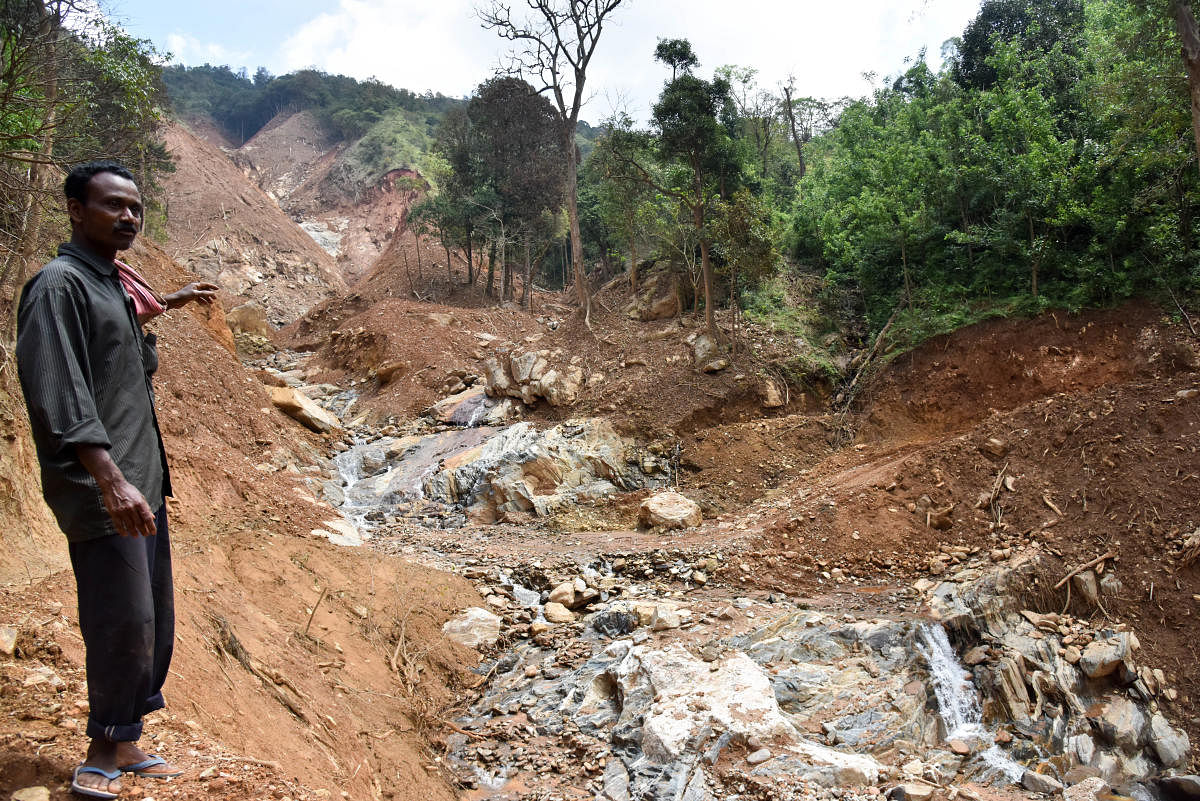
K E Krishnappa Nayaka set foot on Second Monnangeri more than a month after deserting the village due to massive landslides. Upon his return, he found no trace of the 4-acre land on which he grew arecanut, his source of livelihood.
Bright sunshine has buoyed people like Nayaka to come out of the safety of relief camps and venture back into their villages for the first time since August, only to find their homes washed away, their lands unidentifiable and a future uncertain.
While his house was spared, his 4-acre land now resembles a graveyard where rainswept tree barks and electricity poles are the tombstones. Desperate to eke out a living, Nayaka now grows vegetables on a backyard that is roughly a 60x40 patch. After a day’s work, he heads back to a relief camp for the night.
There are still eight relief camps in Kodagu that house 674 people. Last month, there were 55 camps with 6,999 people.
“I trekked up the hills 12 km with my family on the night of August 16 when landslides occurred. I saw it — there was a deafening sound, an air burst from beneath the ground and a big slice of hill collapsed, taking with it everything on the way down,” recounts Nayaka, 48, as he effortlessly manoeuvres the treacherous ravines. “Only those who’ve lost much come back. Those who lost little are happy in relief camps.”
At least 18 people died and 2,508 homes suffered damage since April when it started raining in Kodagu district. Between August 8-19 alone, the district received 700-1712 mm rainfall, a 100-700% departure from normal rainfall. The district administration, the Dogra and Madras Engineering Group (MEG) regiments of the Indian Army, National Disaster Response Force (NDRF) and Civil Defence mobilised a massive week-long rescue operation.
In Kaloor village, Raghu Ponnappa now lives in his partially-damaged house amid a landslide, instead of a relief camp that was his shelter for the past month. “I lost four acres of paddy,” he says, pointing at a swathe of mud pile. “And I want to restore my land in the next one year, with or without the government’s support.”
For Leelavathi Karera, the 2-acre paddy field her family owned is now a grim reminder of the tragedy that struck just a month ago. “It will take at least one year, if the government acts swiftly, to resurvey lands and clear the debris,” she says. “Till then, we are living off 50 kg of food supplies that came through donations.”
The situation is similar in Jodupala, Hemmethalu, Mukkodlu, Makkanduru among other areas ravaged by landslides.
The loss is across the board. Nasir Ahmed, the owner of the 8-acre ‘Riviera The Spring Arc Holiday Villa’ resort, a Rs 50-crore property, says he is now on the streets. The resort has vanished, with only little remnants left to see. “I had invested more than Rs 25 crore on the resort,” a distraught Ahmed says.
That people have started returning to their villages has become possible due to swift restoration of connectivity. The district administration has also identified alternative land away from the affected areas where new homes will be built for the displaced.
These homes will be prefabricated so that people can be moved out of relief camps soon, Kodagu Deputy Commissioner P I Sreevidya said.
However, normalcy is a long way away. “It’s one thing to build new homes, but there are people who’ve lost everything and no one really knows what to do next,” says Nikki Ponnappa, a professional golfer who was part of the rescue effort through the Coorg Wellness Foundation.
According to Galibeedu Gram Panchayat member Dhananjay Agolikaje, rebuilding lives will be possible only if the government provides compensation that is three times the market value of the land people have lost. An acre here costs about
Rs 25-30 lakh. “Right now, those who’ve lost their homes completely will get only Rs 1.01 lakh as compensation. This will not suffice,” he says.
Those housed in relief camps received a temporary compensation of Rs 3,800 by the state government. But locals complained of facing trouble in getting other entitlements. “When the biggest question is that of livelihood, life becomes more difficult if even the rudimentary compensation does not come,” says Chennapanda Naren Somaiah, a local.
Also, there is fear of further calamity. “There are cracks that have become visible on the ground, which means the next time it rains, there will be another landslide,” Nayaka from Second Monnangeri says. “I’m leaving before the next rains.”
Locals also rejected the theory that deforestation caused landslides. “Kaloor, for example, is one village where we protected the environment. We have dense forests. Then how and why did this happen here,” asks Nagesh Kaloor, a former anchor at Akashvani Madikeri.
A delegation of the Kodava Sahitya Academy, led by its president Pemmanda K Ponnappa, visited a few affected areas for a survey. Villagers, in unison, said the government should compensate at least the market value of the land they have lost, if at all they should even consider rebuilding their lives meaningfully. “We’ll try our best,” Ponnappa said, and the delegation left.
